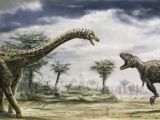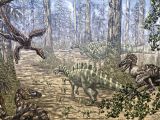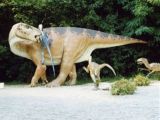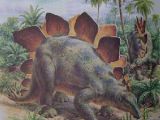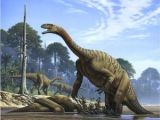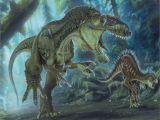There are around 800 species of dinosaurs described worldwide. Dinosaur fossils have been found in all continents, Antarctica included. But, if you ask somebody about dinosaurs, the most popular are those discovered in North America, like Tyrannosaurus and Triceratops. Other hotbeds of dinosaur discoveries are Argentina and China-Mongolia, while Saharan dinosaurs have been made famous by the expeditions led by Paul Sereno. But what about European dinosaurs? Here is a sketch to explain somehow the European dinosaur fauna.
First, when the dinosaurs emerged during the upper Triassic, 220 Ma ago, the continents formed a sole mass of land, Pangaea. This explains why by those times, the same dinosaur genera roamed Germany, Argentina or China. Starting with Jurassic, 200-145 Ma, Pangaea started to split into a northern supercontinent, Laurasia, and a southern supercontinent, Gondwana. Europe was, of course, part of Laurasia. In these supercontinents, dinosaur faunas start to evolve differently. Europe was made now of several islands. During the lower Cretaceous, 150 to 100 Ma ago, the Atlantic Ocean had emerged but the split was recent, and the dinosaur fauna of Europe resembled that of North America. The retreat of the Uralian Seas will allow the European dinosaurs to penetrate in the current Central Asia. During the Cretaceous, the sea waters retreated, and Europe was a larger land mass. But in the upper Cretaceous, 100-65 Ma ago, western Europe was again a big archipelago and the dinosaurs started to have local traits from one region to another.
1. Tarascosaurus salluvicus was 9 m (30 ft) long and was the largest carnivorous dinosaur ever in Europe. It lived 70 Ma ago and was found in southern France. This giant was slighter built than the Tyrannosaurus. It could have been related to T-rex; others say it could have been an Abelisaurid, but these carnivorous dinosaurs are known from Gondwana. This beast was common, living close to freshwaters and coasts.
2. Ampelosaurus ataci was one of the largest European dinosaurs. This sauropod had a curious "ironclad" of bony plates. The ironclad may have been released from the weight of the spine. This 15 m (50 ft) long and 20 tons heavy dinosaur lived 74 Ma ago in southern France.
3. Variraptor was the European cousin of the famous Velociraptor. This dinosaur was up to 3 m (10 ft) long, weighed 50 kg (110 pounds) and it was feathered. Its powerful arms had sharp claws for tearing its prey. It lived in France during the Cretaceous.
4. The terror of the European Jurassic was Megalosaurus, a dinosaur found in UK, France and Portugal. Megalosaurus was up to 12 m (40 ft) long, weighed 1.5 tonnes, it was gregarious and could speed up to 30 km (19 mi) per hour. This is the first dinosaur ever described, in 1676.
5. Rhabdodon lived 70 million years ago in Spain, France, and on Haţeg Island (Romania). Because of living on islands, it was a dwarf compared to its relatives, the Iguanodons.
6. Iguanodon is a precursor of the duck-billed dinosaurs. It lived 140 to 120 Ma ago, in UK, France, Belgium, although possible remains are known from North America, Asia, and Africa. This is the second dinosaur described after Megalosaurus, used to make the term Dinosauria. It could have weighed about 3.5 tons on average and measured up to 13 m (42.6 ft).
7. Stegosaurus, the famous plated dinosaur of the Late Jurassic, was common in both North American and Europe. The first European Stegosaurus was found in 2006 in Portugal.
8. Compsognathus was a small, bipedal, carnivorous dinosaur, the size of a turkey, that lived 150 Ma ago in Europe (Germany, Portugal and France). It fed on lizards.
9. Plateosaurus was a prosauropod dinosaur from the Late Triassic, 216 to 199 Ma ago. It is the oldest known European dinosaur. It was a bulky bipedal herbivore, the largest known dinosaur of its time: up to 10 m (33 ft) in length and weighing 0.7 tons.
10. Archaeopteryx ("ancient wing") is by far the most famous European dinosaur, as it is regarded as the most primitive bird encountered. It lived during the Jurassic Period, around 155-150 million years ago, in Europe. Unlike modern birds, Archaeopteryx had thecodont teeth (like in dinosaurs), three fingers on the tip of its wing with curved claws, and a large tail consisting in flesh, bones and feathers (not just feathers, like in modern birds). The first Archaeopteryx was discovered in 1861 in a limestone quarry in Bavaria. Its feathers were 6 cm (2.4 in) long. Just 7 individuals have been discovered in 150 years. Gastric content shows Archaeopteryx ate fish, but it could have also eaten insects, and the fingers show it could climb trees. Archaeopteryx is one of the first fossils confirming the theory of evolution.
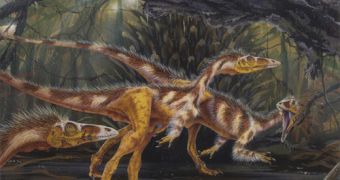
 14 DAY TRIAL //
14 DAY TRIAL // 
